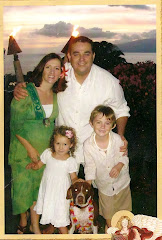Get your own Family Sticker Maker & MySpace Layouts.
THE JOURNEY BEGINS......
Wednesday, February 25, 2009
Monday, February 23, 2009
What is Down syndrome?: It is the most common of chromosomal anomalies, usually resulting in delays in physical and mental development.
What causes it? Down Syndrome is caused by an error in cell division, however it is not known why the error occurs. Most people have 46 chromosomes in each cell with each chromosome grouped into pairs. To form the egg or sperm, the cells divide, with 23 chromosomes to each cell. Then the mother and father each contribute 23 chromosomes to the baby to make a total of 46. In the case of Down Syndrome, the chromosomes do not evenly divide when forming the egg or sperm and the pair of number 21 chromosomes go to one cell and none to the other. The result is that when the egg and sperm combine, the resulting fertilized cell has 47 chromosomes instead of 46, and there are three number 21 chromosomes. This is why Down Syndrome is classified as Trisomy 21.
Did you know?
- That one in every 800-1000 live births is a child with Down syndrome. This represents 5,000 births per year in the U.S.
- The proper term is "Down syndrome" not Down's syndrome. In 1866, Dr. John Langdon Down was the first to describe the condition as a distinct set of characteristics. It is important to use people-first language. For example, a person with Down syndrome is not "a Downs child", "a Downs adult", or a "Down syndrome person".
- Most children with D.S. are born to younger women. 80% of children born with D.S. are born to women younger than 35 years old. However, the incidence of births of children with D.S. increases with the age of the mother.
- Most people with D.S. have IQs that fall in the mild to moderate range of mental disability, they are definitely educable and researchers are still discovering the full educational potential of people with D.S.
- While many people with D.S. used to institutionalized, today people with D.S. live at home with their families and are active participants in the community. They are integrated into the regular educational system, and take part in community activities. They date, socialize, form ongoing relationships, and sometimes marry.
- People with D.S. are not always happy like some people believe. They have feelings just like everyone else in the population. They respond to positive expressions of friendship, and are hurt and upset by inconsiderate behavior..












